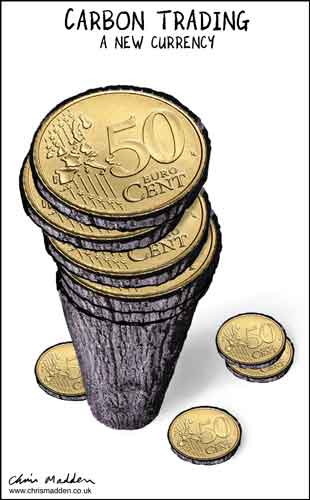
|
http://www.patrickmckenna.com/blog
Page << Prev 70 71 72 73 74 75 76 77 78 79 Next >> of 95
Post #281 – Tuesday, February 5, 2008
Carbon Trading
 Over the past few months I've reported to you on new and emerging practices (see my Post #266 on Infrastructure and Post #248 on Water). Another new area of practice, the carbon offset market may be set to take off. But according to John Goff the technology editor at CFO Magazine, in the main, most corporate executives don't seem to be paying any attention to the emerging complexities of carbon credits. Such ignorance could prove costly to shareholders. A growing number of state emission mandates, such as those imposed in California, are already beginning to create regulatory headaches for some businesses. Federal carbon caps, expected within the next three years, will raise the pain to a whole new level. Over the past few months I've reported to you on new and emerging practices (see my Post #266 on Infrastructure and Post #248 on Water). Another new area of practice, the carbon offset market may be set to take off. But according to John Goff the technology editor at CFO Magazine, in the main, most corporate executives don't seem to be paying any attention to the emerging complexities of carbon credits. Such ignorance could prove costly to shareholders. A growing number of state emission mandates, such as those imposed in California, are already beginning to create regulatory headaches for some businesses. Federal carbon caps, expected within the next three years, will raise the pain to a whole new level.
A few, with an eye toward coming national regulations, are already purchasing high-quality offsets at relatively low prices. When federal legislation hits, the clutch of credits could be turned into a source of windfall profits for their companies. Conversely, those who don't understand the complexities of carbon commodities could find themselves paying high prices for low-quality offsets in a seller's market. And, according to John, federal carbon legislation will almost assuredly trigger a steep rise in the price of CO2 credits.
Some businesses, like VW and Expedia.com, see immediate value in carbon credits. They use the credits to help customers offset the carbon output from products and services. Others, like Green Mountain Coffee Roasters and Timberland, purchase credits to help reach "carbon-neutrality" — CO2 nirvana, where carbon discharges (known as a carbon footprint or profile) are offset by carbon reductions.
This activity has fueled an increase in the trading of offsets. In 2006, trading volume of carbon offsets, such as Carbon Financial Instruments and Renewable Energy Certificates (RECs), jumped 200 percent in the voluntary markets (primarily the United States). Observers believe that market is now worth at least $100 million. Privately, those same observers talk about a $4 billion carbon-trading market once federal caps are approved.
That prospect worries some environmentalists, who argue that purchasers of offsets are simply outsourcing their obligation to combat climate change. Others claim that offsetting enables a company to brand itself "green" without actually being green. Those critics say buying carbon offsets does little to change how carbon-addicted companies operate.
And who knows what they're buying? A list of current CO2 trading credits reads like an environmentalist's eye chart. Derived from an array of carbon-reduction schemes, the credits are often calculated using different methodologies and accounting standards. Third-party brokers don't necessarily bring clarity to the subject. One study conducted by the not-for-profit Clean Air–Cool Planet rated 30 such firms across seven criteria, including the use of third-party verification. Only eight vendors merited a passing grade, and the report went on to note that "few retail offset providers provide anywhere close to the amount of project-specific information [to allow buyers] to effectively evaluate offset quality."
And this potential for purchasing worthless credits explains just one of the reasons why a few progressive law firms are already getting into the carbon issue.
Post #280 - Friday, January 25, 2008
Your Monthly Review
 As a managing partner put it to me the other day, “I have monthly reviews with each of my practice group leaders. We talk about 3 things: As a managing partner put it to me the other day, “I have monthly reviews with each of my practice group leaders. We talk about 3 things:
- What’s gone well (and how can we do more of that);
- What needs improvement (and how can we improve faster); and
- What’s the general feeling of how things are going in relation to your goals.”
Three simple questions that get right to the heart of what you’re focusing on . . . living your strengths; shoring up the weaknesses enough that they don’t bring your strengths down; and taking time to think about how you FEEL things are going.
NICE!
Post #279 - Friday, January 25, 2008
 Whispering The 'R' Word Whispering The 'R' Word
This is the “biggest finance crisis since WWII,” says George Soros.
Financials . . . builders . . . shippers and retailers . . . one by one, the sectors are getting hit. And the news is almost all bad: foreclosures, house sales, unemployment, consumer confidence, inflation . . . osses . . . declines. One problem after another . . . one loss after another.
During the last 25 years or so inflation went down and unemployment declined to such low levels that economists didn’t think it was possible for it to go lower. “Full employment” they pronounced. But now the inflation rate is back to levels that caused Richard Nixon to panic in the early ’70s.
Fannie and Freddie – two of the largest mortgage lenders in the nation – could see losses of $16 billion, says Credit Suisse. Wachovia has seen its earnings “vaporize.” Bank of America’s net has been cut by 95%. Meanwhile, mortgage defaults in California are running 114% ahead of last year. They’re at a 15-year high.
Based on all of the above . . . I would say that we’re already in a recession.
So watch out!!!
Post #278 - Wednesday, January 16, 2008
Only A Few Days Left To Register
My First 100 Days Master Class is scheduled to GO . . . on Tuesday, January 29 in New York at the AMA Executive Conference Center - 1601 Broadway (at 48th and Broadway)

FIRST 100 DAYS
MASTER CLASS FOR
THE NEW MANAGING PARTNER
Frankly, your master class really made me think about how to manage this transition. Not an easy thing in light of the circumstances. By the way, if you have graduate courses that continues on from this master class, please let me know.
Ira C. Kaplan
BENESCH FRIEDLANDER COPLAN & ARONOFF
We currently have nine (9) new managing partners / firm leaders registered to be in attendance from a range of law firms: 8 - US and 1- (prominent) Mexico City firm. Four of our registrants hail from firms of over 300 lawyers, while the remainder are from firms of 100 to 300 lawyers in size. As this is a limited attendance event, there are just a couple of seats remaining.
Our Participants have been informed:
The day promises to be a busy one such that you should expect to receive a 50-page booklet of participant materials, be engaged in discussions with colleagues from across the country, and participate in the analysis of a couple of case studies and a half-dozen exercises. Our intent is to be as pragmatic and helpful as possible to the issues and challenges on your agenda. To that end, we have two preparatory homework assignments for you:
(1) Attached is a short Pre-attendance Questionnaire (7 Questions – about 10 minutes) that we would ask you complete and e-mail back.
(2) In a very special arrangement that we have made with a firm called Hogan Assessments you are being invited (without cost) to partake of a leadership assessment instrument designed to help you identify those conditions, that particularly when you are under stress, can derail your leadership efforts. We will be addressing this topic in detail on the afternoon of the 29th and so to the extent that you have participated in this assessment, the presentation and discussions will be far more meaningful and helpful to you.
Our agenda for the day will see us covering topics such as understanding the four distinct phases of leadership transition; working with your partners, your predecessor, any disappointed rival, and your administrative professionals; developing your personal strategic agenda; enhancing your leadership influence; managing change; and much, much more.
Don't delay. Contact the good folks at ARK Seminars today.
Post # 277 - Thursday, January 10, 2008
2007 Best Sellers
My good friend and fellow author, David Maister kindly sent me a copy of a newsletter he received today, from the prestigious Books For Business operation announcing their 2007 Annual Best Sellers List:
Here’s a list of our year 2007 best sellers. These are the books that continue to sell, year in and year out. Make sure you have copies in your office library.
 #12. #12.
First Among Equals: How to Manage a Group of Professionals
Patrick McKenna & David Maister
Free Press
ISBN: 9780743267588 Paperback (April 2005)
In this guide to managing in professional environments,
two renowned consultants show professional group managers
lacking formal authority how to lead colleagues to peak performance.
Not bad for a five-year old vintage!
Post #276 - Thursday, January 10, 2008
Downsizing Is Here
The future in a single word: downsizing. Downsizing is going to be popular, hip, cool, fashionable and maybe even, sensible.
In a statement blaming "unexpected and persistent volatility" in sectors of the financial markets that have affected the capital markets, Cadwalader, Wickersham & Taft announced that it downsized 35 lawyers across their US offices.
And Cadwalader is only the latest to have engaged in this fashionable exercise, all in response to last year's credit crunch. In December, Wall Street’s Thacher Proffitt & Wood notified 50 of its associates that they faced the axe; while structured finance boutique McKee Nelson significantly restructured its groups by offering associates beneficial terms to leave.
Speaking of downsizing, India’s Tata Motors just downsized the family car. Earlier this week it took the drapes off its new Nano – which it has put on the market for just $2,500. The photo makes it look like a slightly stretched Smart Car. Not bad really. As far as I know, the vehicle is only for sale in India, but if it were on the lots in North America, I predict that it would find plenty of buyers. This little tin-can gets 50 mpg.
Stay tuned. I think there is much more to come.
Post #275 – Wednesday, January 9, 2008
Where Do You Spend Your Management Time?

While currently immersed in a couple of strategic planning assignments with client firms, I’m reminded of something I learned awhile back about where firm leaders spend (or don’t) their precious and limited management time . . .
I often ask of managing partners a couple of questions that painfully illuminates where they spend their time. First: What proportion of your management time is spent solving problems versus what proportion is spent on exploring new opportunities? After a rather awkward reflection period, the answer I will usually elicit is about 80% on solving problems and 20% on exploring opportunities.
I suspect that it is really more like 95% on problems and 5% on opportunities, but let’s analyze what this division of time infers. This means that as the firm leader, you are spending 80% of your time and energy looking backwards and fixing things, while only 20% looking forward and creating things. Firms operating in this mode will never lead in their marketplace.
So why does this happen? Well, it should be obvious that most professionals are veteran problem solvers. We are trained to resolve the issues, put out the fires, correct the underperformance, and generally “fix” the problem. There is a powerful gravitational pull that unconsciously moves us toward fixing things instead of innovating, toward restoring instead of increasing, and toward reacting rather than being proactive.
We need to understand that fixing things, while however noble, simply restores the prior performance or condition, which is comfortable, but limits value. However, if your focus is on improving the condition, on inspiring entrepreneurial endeavors, on being innovative; then your intent is not on restoring the status quo, but on developing a level of performance that exceeds any previous standards.
There is a follow-up question we then pose. Of the time you spend on exploring opportunities, (remember it was reported to be 20% of the total) how much of that time is directed toward pursuing billable production, winning the next big transaction or responding to a competitor, (the present) versus pursuing the development of entirely new skills, new services or new technologies (the future)?
Again, if I were generous in reporting what I have learned, the average managing partner spends about 60% of their time exploring present opportunities and 40% on future opportunities. That drives a point worth scrutiny: What kind of a future is likely to be created by a firm leader spending about 8% of his or her total management time and energy focused on that future? And this is in firms that have a managing partner who spends all of their available time on management matters. Those managing partners spending less than full-time usually have next to no time for the future, except of course, during that one-day, off-site annual planning retreat. (Is it any wonder why so many of these retreat-generated “strategic plans” are dead on arrival!)
Post #274 – Friday, January 4, 2008
Leadership Reflections For The New Year
Someone once said, “being a leader is being the guide on the side, not the sage on the stage.” Going into a new year, here are some guidelines to reflect upon:
• Create goals that are both realistic and unrealistic; commit your goals to writing and ensure that they are measurable, and then celebrate the achievement of each goal.
• Be genuinely interested in the needs of others and be interested in the growth of others even more so than the others are at times.
• Know that all endeavors will not be easy and will not happen the way you would have planned or wished. Inspire persistence even after the first, second, and third rejection of an attempt.
• Infuse a need to grow by teaching, rather than giving the answers.
• Maintain an awareness of just how much your body communicates and remember that your body continues talking long after your lips stop moving.
• Fuss over others’ events, achievements, families, and friends.
• Avoid assuming that your communication or personality style is the one everyone else has and learn to modify your communication style to the style of others. Adhere to the principle that “communication is not what was said, but what is received.”
• Give yourself permission to leave things undone and let go of needing to be perfect, and of needing everyone else to be perfect.
• Become clear and comfortable with the fact that leadership does not mean “being the most popular one on the playground.”
• Believe that people do what they get paid attention for, and be spontaneous, as well as scheduled in your recognition efforts; but avoid giving a public person, private recognition as they will see little or no value in it.
• Remember that money does not motivate for the long term and becomes expected.
• Address only areas of behavior and performance when being critical; and avoid engaging emotions until all angles have been examined. Maintain clarity on the fact that attitudes are not taught or changed without the owner’s consent.
Exhibit leadership traits as part of who you are, not what your particular title is!
Post #273 - Friday, January 4, 2008
IBA Best Practice Guidelines
 After almost two years of collaboration, the International Bar Association (IBA) Group Member Firms and the Law Firm Management Committee have finalized ‘Best Practice Guidelines’ for law firm governance. After almost two years of collaboration, the International Bar Association (IBA) Group Member Firms and the Law Firm Management Committee have finalized ‘Best Practice Guidelines’ for law firm governance.
As an IBA member, I'm please to see that these guidelines identify certain general principles and standards to help law firms manage their practices in a way that will provide an optimal environment for lawyers to develop their skills and for law firms to stand up to the challenges they face. Such challenges include: the increasing power of governments, the growing complexity and intrusiveness of regulation, the weakness of the processes of justice, corruption, social change and evolving societal expectations. The guidelines include recommendations for law firms in respect of their employees, clients and the community at large.
Post #272 - Friday, January 4, 2008
Progress In The Profession

The UK Government has decided solicitors and other advocates, in addition to barristers, will have the option to wear wigs where they would be worn by members of the bar.
The new practice direction follows a consultation on the issue by the former Department of Constitutional Affairs, now the Ministry of Justice, along with the Lord Chief Justice.
Solicitors will be allowed to don wigs from 2 January. In magistrates’ courts advocates will continue to appear without robes and wigs.
Page << Prev 70 71 72 73 74 75 76 77 78 79 Next >> of 95
|
|


 Ashridge House
Ashridge House  11226 - 60 Street
11226 - 60 Street  Edmonton, Canada
Edmonton, Canada  T5W 3Y8
T5W 3Y8